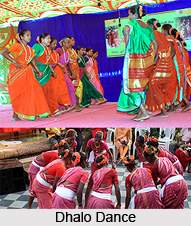 Dhalo dance is one of the most popular rural dances of Goa. Dhalo is performed by women folk on the moonlit night of Hindu `Pausha` month. The dance is performed by kunbis, Bhandari, Naik, Gabit and Gaudi communities. According to legend, Radha used to sing love songs known as dhalos to Lord Krishna. Earlier dhalos referred only to the love of Krishna and Radha. Gradually, people developed the songs which were sung in praises to other Gods also.
Dhalo dance is one of the most popular rural dances of Goa. Dhalo is performed by women folk on the moonlit night of Hindu `Pausha` month. The dance is performed by kunbis, Bhandari, Naik, Gabit and Gaudi communities. According to legend, Radha used to sing love songs known as dhalos to Lord Krishna. Earlier dhalos referred only to the love of Krishna and Radha. Gradually, people developed the songs which were sung in praises to other Gods also.
Significance of Dhalo Dance
Dhalos are performed for praying for divine intercession to get rescued from all evil powers, improve relations and have peace in the village. The festival is celebrated according to the Hindu calendar, during the month of Pausha and Magha.
Custom of Dhalo Dance
Dhalo usually begins on a Wednesday or on a Sunday. Prior to the celebrations, the women decorate the open space of their house and the temple with rangoli. Women from the villages are also welcomed to participate in the dance. However, widows do not take part in the dhalos. Women offer talli i.e. rice, moog and jiggery which are then cooked and served to those present.
The leader of the village locally known as Mandkann invokes a salutation to the divinity, the Earth Mother and seeks her blessings for the whole village and for the festival rituals.
Performance of Dhalo Dance
The performance takes place in a sacred open space known as mand where all the village folk gather to sing, dance or play music as part of ritualistic performance. As per requirements, the ladies dress up as men for the rituals.
The women sing about the clothes who participate in the dance. The songs are typical but sometimes there are simple and spontaneous additions. The singing continues till late in the night.
Around midnight the various dances and games begin. The dancers arrange themselves in two parallel rows of 12, facing each other. They form a link within themselves in a tribal fashion with an arm-around-the-back arrangement, singing in unison. In general, two rows of women face each other by swaying forward and backward while singing the stories of their life and the contemporary society. Stories are narrated and many events are described through the songs and dances. These dances are performed on the first six nights of Dhalo. Originally the themes of the songs sung during the Dhalo were about Krishna`s romance, Ramayana and the Mahabharata. However of late Marathi and Hindi songs are included in the repertoire. On the concluding day, women wear all sorts of fancy dresses and even enact like that of men folk.



















